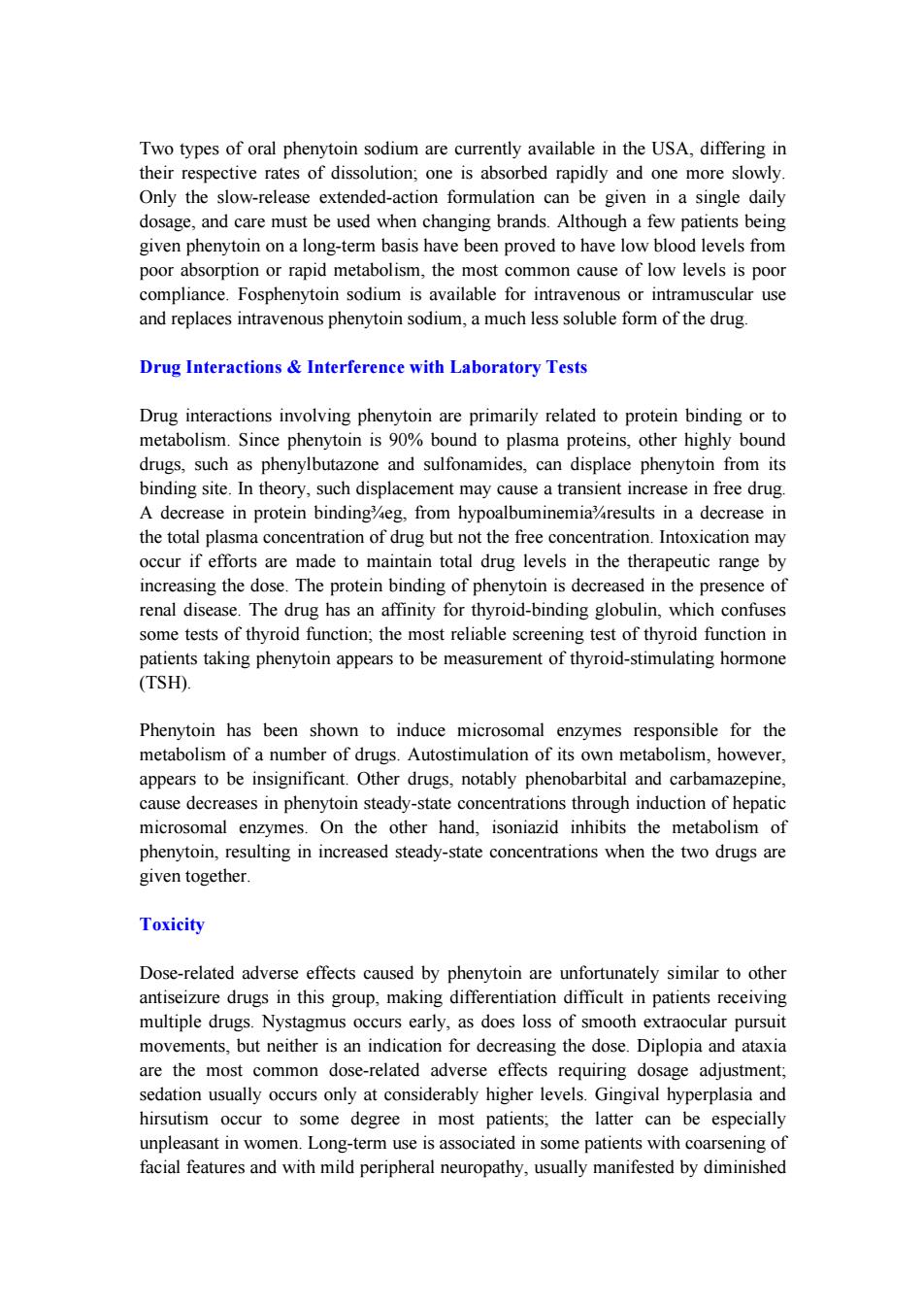正在加载图片...

Two types of oral phenytoin sodium are currently available in the USA,differing in their respective rates of dissolution;one is absorbed rapidly and one more slowly. Only the slow-release extended-action formulation can be given in a single daily dosage,and care must be used when changing brands.Although a few patients being given phenytoin on a long-term basis have been proved to have low blood levels from poor absorption or rapid metabolism,the most common cause of low levels is poor compliance.Fosphenytoin sodium is available for intravenous or intramuscular use and replaces intravenous phenytoin sodium,a much less soluble form of the drug. Drug Interactions Interference with Laboratory Tests Drug interactions involving phenytoin are primarily related to protein binding or to metabolism.Since phenytoin is 90%bound to plasma proteins,other highly bound drugs,such as phenylbutazone and sulfonamides,can displace phenytoin from its binding site.In theory,such displacement may cause a transient increase in free drug. A decrease in protein bindingeg,from hypoalbuminemiaresults in a decrease in the total plasma concentration of drug but not the free concentration.Intoxication may occur if efforts are made to maintain total drug levels in the therapeutic range by increasing the dose.The protein binding of phenytoin is decreased in the presence of renal disease.The drug has an affinity for thyroid-binding globulin,which confuses some tests of thyroid function;the most reliable screening test of thyroid function in patients taking phenytoin appears to be measurement of thyroid-stimulating hormone (TSH). Phenytoin has been shown to induce microsomal enzymes responsible for the metabolism of a number of drugs.Autostimulation of its own metabolism,however, appears to be insignificant.Other drugs,notably phenobarbital and carbamazepine, cause decreases in phenytoin steady-state concentrations through induction of hepatic microsomal enzymes.On the other hand,isoniazid inhibits the metabolism of phenytoin,resulting in increased steady-state concentrations when the two drugs are given together. Toxicity Dose-related adverse effects caused by phenytoin are unfortunately similar to other antiseizure drugs in this group,making differentiation difficult in patients receiving multiple drugs.Nystagmus occurs early,as does loss of smooth extraocular pursuit movements,but neither is an indication for decreasing the dose.Diplopia and ataxia are the most common dose-related adverse effects requiring dosage adjustment; sedation usually occurs only at considerably higher levels.Gingival hyperplasia and hirsutism occur to some degree in most patients;the latter can be especially unpleasant in women.Long-term use is associated in some patients with coarsening of facial features and with mild peripheral neuropathy,usually manifested by diminishedTwo types of oral phenytoin sodium are currently available in the USA, differing in their respective rates of dissolution; one is absorbed rapidly and one more slowly. Only the slow-release extended-action formulation can be given in a single daily dosage, and care must be used when changing brands. Although a few patients being given phenytoin on a long-term basis have been proved to have low blood levels from poor absorption or rapid metabolism, the most common cause of low levels is poor compliance. Fosphenytoin sodium is available for intravenous or intramuscular use and replaces intravenous phenytoin sodium, a much less soluble form of the drug. Drug Interactions & Interference with Laboratory Tests Drug interactions involving phenytoin are primarily related to protein binding or to metabolism. Since phenytoin is 90% bound to plasma proteins, other highly bound drugs, such as phenylbutazone and sulfonamides, can displace phenytoin from its binding site. In theory, such displacement may cause a transient increase in free drug. A decrease in protein binding¾eg, from hypoalbuminemia¾results in a decrease in the total plasma concentration of drug but not the free concentration. Intoxication may occur if efforts are made to maintain total drug levels in the therapeutic range by increasing the dose. The protein binding of phenytoin is decreased in the presence of renal disease. The drug has an affinity for thyroid-binding globulin, which confuses some tests of thyroid function; the most reliable screening test of thyroid function in patients taking phenytoin appears to be measurement of thyroid-stimulating hormone (TSH). Phenytoin has been shown to induce microsomal enzymes responsible for the metabolism of a number of drugs. Autostimulation of its own metabolism, however, appears to be insignificant. Other drugs, notably phenobarbital and carbamazepine, cause decreases in phenytoin steady-state concentrations through induction of hepatic microsomal enzymes. On the other hand, isoniazid inhibits the metabolism of phenytoin, resulting in increased steady-state concentrations when the two drugs are given together. Toxicity Dose-related adverse effects caused by phenytoin are unfortunately similar to other antiseizure drugs in this group, making differentiation difficult in patients receiving multiple drugs. Nystagmus occurs early, as does loss of smooth extraocular pursuit movements, but neither is an indication for decreasing the dose. Diplopia and ataxia are the most common dose-related adverse effects requiring dosage adjustment; sedation usually occurs only at considerably higher levels. Gingival hyperplasia and hirsutism occur to some degree in most patients; the latter can be especially unpleasant in women. Long-term use is associated in some patients with coarsening of facial features and with mild peripheral neuropathy, usually manifested by diminished